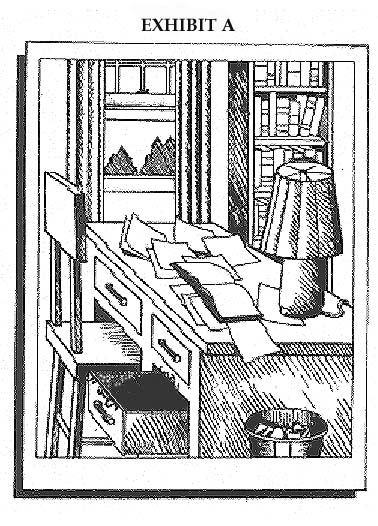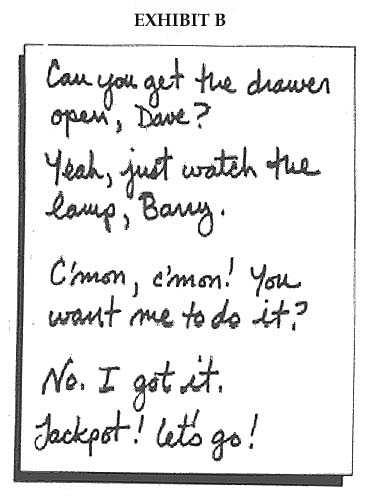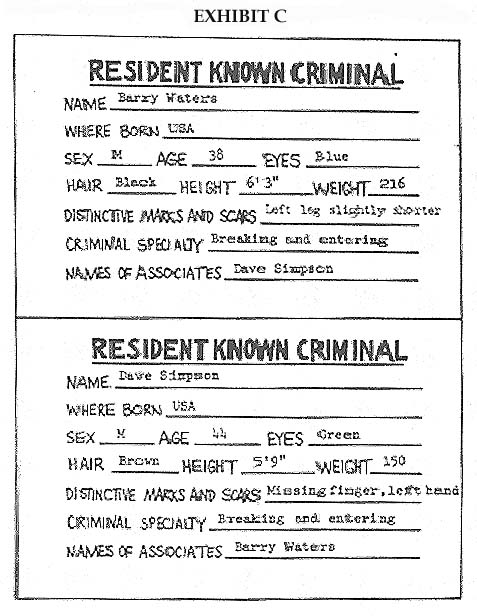| "The Case of the Speedy Thieves" | ||
| Adapted from: Miller, Marvin. You Be the Jury. Illustrator, Bob Roper. New York: Scholastic, 1987, pp. 63-69. | ||
EXHIBIT A |
EXHIBIT B |
EXHIBIT C |
| Click on the pictures to see them at their full-size. |
||
| On Sunday, June 20, Mr. Ethan Roberts was in his bedroom, quietly reading. Around 4 p.m., he decided to take a nap. “I lowered the shades and darkened the room. I was just drifting off to sleep when I heard a crash in the next room. Strange noises followed the crash, and I was certain that someone had just broken into the den next to my bedroom,” Mr. Roberts told police later. | ||
Mr. Roberts, unfortunately, did not have a telephone in his bedroom, and he did not want to risk getting hurt by taking the intruder by surprise. He did, however, put his ear to the closed bedroom door that connected to the den and strained to hear what was going on. Roberts told police, “I knew that two men had broken in and a robbery was in progress. I remained silent, but I managed to grab a pen and a piece of paper to write down what I heard.” After the room fell silent, Mr. Roberts waited ten minutes, then cautiously opened the door. |
||
|
||
| Upon entering, Roberts saw that the den’s window had been smashed and opened. Everything else was in order except the locking bottom drawer of his desk which had been pried open. The drawer, which previously had $2000 and some antique jewelry inside, was completely empty. | ||
| Mr. Roberts immediately called the police. When they arrived, they found the den as described above. EXHIBIT A is a photograph of the room taken shortly after the police arrived. A rock, used presumably to smash the window, cannot be seen in the picture because it was found on the far side of the desk. Police inspected the premises, including the completely dark bedroom Mr. Roberts was in during the robbery. They found no fingerprints except for Mr. Roberts’. The desk drawer, they concluded, had probably been pried open with a crowbar due to the scratches and metal residue in the wood. The rock came from Roberts’ garden under the smashed window. Shards of the window’s glass littered the ground outside, and two sets of footprints led to and away from the window. One set seemed to belong to a taller man who walked unevenly—the left footprints were slightly deeper than the right. | ||
| EXHIBIT B is the note written by Mr. Roberts while the robbery was in progress. While the information Mr. Roberts had written was scant, police searched their files. EXHIBIT C is the records of two criminals whose first names matched the ones Mr. Roberts had written down. These men were known accomplices. | ||
| Police did question Roberts about the names of the criminals. Roberts remembered hiring Barry Waters to paint his garage two weeks ago. Waters had been recommended by a neighbor as “a guy who did good work.” Roberts claims he did not know about Waters’ troubles with the law. | ||
| After talking with police, Roberts called his insurance company to file a claim. The claim is pending, according to the company, because “Mr. Roberts has reported two other robberies in the last three years, and the robberies remain unsolved. Should the accused men in the case be found guilty at trial, we will settle Mr. Roberts’ claim.” | ||
| You are a member of the investigative team. Analyze the evidence in the story and the exhibits. Look for clues about this incident. Who do you think is responsible for this robbery? | ||


